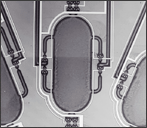

TINY DRUG DELIVERY SYSTEM DEVELOPED BY CAL ENGINEERS
Engineers at Berkeley have developed microscopic mixers and bubble pumps that fit on a patch the size of a thick credit card and can deliver drugs through a needle no larger than a mosquito's snout.
Future patients may be able to slap such a drug delivery card on their arms and give themselves a controlled drip of insulin or a brief regimen of antibiotics, said Dorian Liepmann, assistant professor of mechanical engineering at Berkeley and a leader of the research project.
Liepmann predicts these cards would be useful as emergency medicine or merely as an easy way to deliver a number of drugs. And since they would deliver drugs continuously and in small doses, they could even out fluctuations in blood sugar and perhaps prevent the circulatory damage common in diabetics.
Though still under development, this drug delivery system is one of the first practical devices to emerge from a field called microfluidics -- the science of moving and mixing fluids in spaces no larger than a human hair.
This tiny scale precludes the use of turbulence -- the type of mixing that occurs when you stir cream into coffee.
Mixing is accomplished by pumping fluid in and out of four holes in the chamber using a bubble and a microheater. As the bubble forms, fluid is pushed down the channel. When the heater is turned off, the bubble collapses, drawing fluid back up the channel.
![]()

[Table of Contents] [Berkeley Magazine Home] [UC Berkeley Home Page]
Copyright 1998, Regents of the University of California. All rights reserved.
Comments? E-mail ucbwww@pa.urel.berkeley.edu.